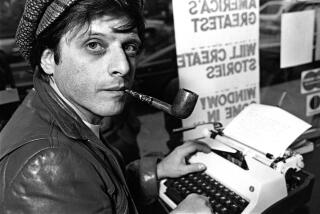Museum is presenting Edison in his best light : Inventor’s Florida estate now has a curator who is making a visit to the winter home a more illuminating experience.
- Share via
FT. MYERS, Fla. — Thomas Alva Edison didn’t exactly invent this city when he first came here 110 years ago, but he did illuminate it--with both his presence and the incandescent bulb. And his neighbors on the Gulf Coast have been basking in the glow ever since.
The winter home that America’s most prolific inventor put up on the banks of the Caloosahatchee River has long attracted thousands of tourists, who stroll the lush grounds and peek inside Edison’s living room and laboratory. On display is a dazzling sample of Edison’s genius--in phonographs, radios, talking dolls and light bulbs, some burning for 70 years.
But only recently with the hiring of the museum’s first curator--and coincident with the publication this year of a major Edison biography--has the Edison Museum begun to make the transition from beach blanket alternative to a national historical site with the appeal of Williamsburg and Monticello.
“Before we just did general maintenance and gave a walking tour, which was probably 95% accurate,” says Gary Thomas, acting historical division director for the city of Ft. Myers, which owns the 14-acre property. “Now we are trying to give a more professional presentation. We are taking ourself seriously as a museum.”
A two-hour, $10 visit to the Edison Museum remains one of Florida’s least-known but most-rewarding bargains. There is a modest gift shop, but refreshments come from vending machines. This is no Disney World.
Instead, a stop at the Edison home offers a glimpse into both Florida’s past and the lives and minds of some of America’s creative giants--including the inventor and his friends Henry Ford, Harvey Firestone, Charles Lindbergh, Helen Keller and the naturalist John Burroughs.
Seeking a balmy, curative escape from New Jersey winters, Edison was in poor health when he paid $2,750 for the property in 1885. After building a house of imported Maine lumber, he and his second wife, Mina, wintered there many years until his death in 1931 at age 84.
Although the Edison estate has been open to the public since soon after his widow deeded it to the city in 1947, it was not until Michele Wehrwein Albion was hired as curator three years ago that the breadth of the legacy began to be explored. “We have a fabulous archive of original material here, much of it never available to the public before,” Albion says.
“Edison’s books, for example, in which he made notes in the margins, the dates when read. A photograph of Helen Keller, blind and deaf, in a gorgeous white dress, on which she wrote to Edison, also deaf: ‘To Mr. Edison--Not loudness, but love, sounds in your ear, my friend--Helen Keller.’
“We have recordings and film of the Edisons speaking. There is so much here.”
As she works her way through boxes of uncatalogued material, Albion is making plans to exhibit the unknown treasures. She also receives artifacts and Edison memorabilia from local residents.
Although Edison’s primary residence and laboratory were in Menlo Park, N.J., he was not a man who stopped working when he came south for the winter. His laboratory and study here are jammed with test tubes and notebooks, just as he left them. And the array of phonographs, batteries, stock tickers, telegraphs--representing just a few of the 1,093 patents he secured--is stunning.
Also now open is the house built next door to Edison’s by his pal Henry Ford.
The grounds are a botanical wonderland of exotic subtropical vegetation from around the world, from the stately Cuban royal palms that line the boulevard in front of the estate to the 70-year-old banyan tree that now shades an area larger than a football field.
Attendance has been declining in recent years, from a high of 482,000 visitors in 1991 to 315,000 last year, Thomas says. The city spends $225,000 a year on advertising, and the Edison Museum last year generated about $2.9 million in revenue, about 4% of the budget in this city of 50,000.
The dip in visitors, mirrored throughout Florida, has led the city to put on hold plans for a $10-million museum expansion that would include a food court and a theater.
But Thomas is confident that as the search for a permanent director and professional museum accreditation continues, the estate will take its place as a major stop on the tour of American historical shrines. “This is a gem, still in the rough,” Thomas says. “We want to polish it up.”
Or, as Edison prophesied when the nation’s population was considerably smaller: “There is only one Ft. Myers, and 90 million people are going to find out about it.”
Times researcher Anna M. Virtue in Miami contributed to this story.
More to Read
Sign up for The Wild
We’ll help you find the best places to hike, bike and run, as well as the perfect silent spots for meditation and yoga.
You may occasionally receive promotional content from the Los Angeles Times.






